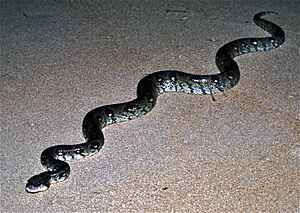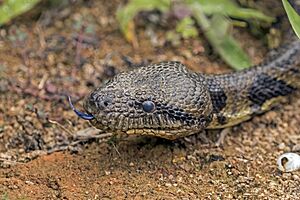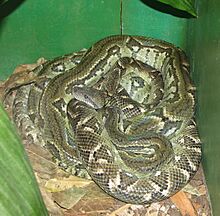Madagascar tree boa facts for kids
Quick facts for kids Madagascar tree boa |
|
|---|---|
 |
|
| Conservation status | |
| Scientific classification | |
| Genus: |
Sanzinia
|
| Species: |
madagascariensis
|
| Synonyms | |
|
|
The Sanzinia madagascariensis, also known as the Madagascar tree boa or Malagasy tree boa, is a type of boa snake. It lives only on the island of Madagascar. Like all boas, it is not venomous, meaning it doesn't have poison. It was once thought to be the same as the Nosy Komba ground boa.
Contents
Description
Adult Madagascar tree boas usually grow to be about 4 to 5 feet (122–152 cm) long. Some can even reach 6 to 7 feet (183–213 cm). Females are typically larger than males.
These snakes are green in color. They have special heat-sensing pits on their lips. These pits help them find warm-blooded prey in the dark. You can find them on the eastern side of Madagascar.
Where They Live
The Madagascar tree boa lives only in Madagascar. This means it is an endemic species. They prefer to live in trees and bushes. You will often find them near water sources. This includes streams, rivers, ponds, and swamps.
Conservation Status
The Madagascar tree boa is currently listed as a species of Least Concern (LC). This means it is not at high risk of extinction right now. It is found in many places, even in areas where habitats have changed. There are no major known threats to this snake's survival.
However, it is also listed under CITES Appendix I. CITES is an international agreement to protect endangered animals and plants. Appendix I means the species is threatened with extinction. Because of this, international trade of these boas is mostly banned. It is only allowed for things like scientific research, not for selling as pets.
What They Eat
The Madagascar tree boa spends most of its time in trees. It is also mostly nocturnal, meaning it hunts at night. It eats small mammals and birds.
The heat-sensing pits on its lips are very useful for hunting. They help the snake find its prey in the dark. Sometimes, these boas will also come down from the trees. They do this to actively hunt for small mammals on the ground.
Reproduction and Life Cycle
Madagascar tree boas give birth to live young. This is called being ovoviviparous. A female can have up to 12 babies at one time. Each baby snake is usually about 15 inches (38 cm) long when born.
When a female boa is pregnant, her skin gets darker. This helps her absorb more heat from the sun. More heat helps her babies grow inside her. After she gives birth, her skin color returns to normal. This happens after she sheds her skin.
Newborn boas are a bright red color. This bright color might act as a warning to predators. It tells them to "stay away." The red color also helps the baby snakes hide. It camouflages them among the brightly colored flowers in the treetops.
Taxonomy
The scientific name for this snake is Sanzinia madagascariensis. For a while, there was some confusion about its name. Scientists sometimes moved it into the Boa group. However, it was later shown that the boas from Madagascar are different from the Boa group. So, Sanzinia madagascariensis is the correct and accepted name for this species.




